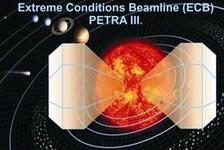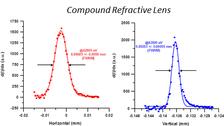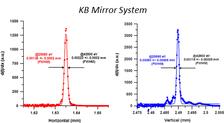- Fixed Energy @ 25.7, 42.8, and 60 keV
- Sample Stack with ~100 nm precision
- Omega Rotation with less than 2 µm spherical confusion
- Area Detectors in forward geometry (PerkinElmer, GaAs LAMBDA)
- Focusing with KB mirror and CRL lens systems
- Double-side laser heating (on axis & off axis) with two NIR fiber lasers (1064 nm)
- Single sided laser heating (off axis) with CO2 laser (10000 nm)
- Double-side temperature measurements
- Sample inspection
- Online ruby fluorescence
|
Aim of the Extreme Conditions Beamline is to provide tools for studying materials at extreme states of matter such as high-pressure and simultanious high-/low-tempertures, with a strong emphasis on the time resolved capabilities to promote diffraction work on dynamic phenomena at extremes. |
Experimental Setup
Focusing, Beam Size Characteristics
Micro Focus
- 2 (H) x 2 (V) µm2 FWHM (Kirkpatrick Baez (KB) Mirrors) at energies of 25.6, 42.7
- 8 (H) x 3 (V) µm2 FWHM (Compound Reflective Lenses, CRL) at energies of 25.6, 42.7 (Be lenses)
- sub-microm focus (ca. 0.8 x 0.8 µm2 FWHM, CRL) at energy of 25.6 keV
X-ray Micro-Diffraction Techniques for high-P & high/low-T experiments
Monochromatic X-ray Diffraction Techniques
- Powder x-ray diffraction
- Single-crystal x-ray diffraction
- X-ray scattering on non-crystalline materials (PDF Studies)
- Radial x-ray diffraction for texture analysis
Fluorescence Spectroscopy at High Energy
- Fluorescence with Micro-capillary
- Laser-heating and Fluorescence
Pink Beam X-ray Diffraction Techniques
- Powder Diffraction (under development)
- Single Crystal Diffraction (under development)
Sample Environments
Sample Environments to Conduct Static Pressure Experiments
- High-pressure in the DAC (powder & single crystal diffraction, scattering on non-crystalline materials)
- High-pressure and -temperatures with double sided CW laser heating (powders diffraction only)
- High-pressure and -temperatures with one sided CO2 laser heating (powder diffraction only, under commissioning)
- High-pressure and -temperatures with resistive heated DACs (powder & singel crystal diffraction, scattering on non-crystalline materials)
- High-pressure and low temperature with the DAC in the helium flow cryostat (powder & single crystal diffraction) at 30 and 4 K (for both runs in 2023 there is a shortage in liquid He, so cryostat experiments are postponed until 2024)
Sample Environments for Dynamic Experiments (powder diffraction only)
- Time-resolved high-pressure studies in the membrane (mDAC) and the dynamic (dDAC) driven diamond anvil cell
- Time-resolved high-pressure and CW laser-heated DAC
- Time-resolved high-pressure and pulsed/flash laser heated DAC

The BMBF funded the project 05K19WC1 Sub-micron focusing and positioning setup Universität Bayreuth, titled "Strukturuntersuchungen an Submikronkristallen unter extremen Bedingungen: Einkristall-Röntgenbeugung bei Drücken über 200 GPa und variablen hohen Temperaturen" (Natalia Dubrovinskaia)










